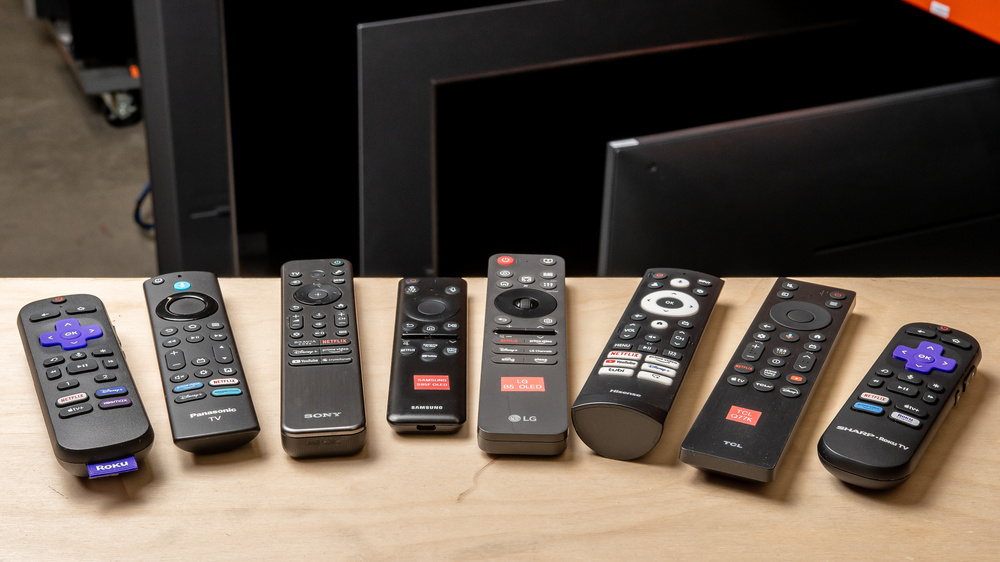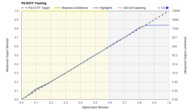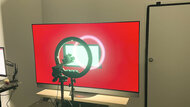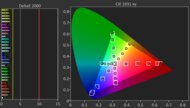Shopping for a new TV can be challenging; with so many different manufacturers, it can be hard to know which is the best TV brand and where to start. Some TV brand names are well-known, but popularity doesn't equate to being the best, as even the best brands' entry-level models don't perform well. Some budget-friendly TV brands have made waves in the market and often release models that are better than more expensive options.
Most of our recommendation articles take price into consideration, so a TV that performs slightly worse might be recommended over a brand's flagship model if we feel like the extra cost isn't worth it for most people. However, for the purpose of this article, we pick a model from each brand that performs the best overall across over 350 tests that we do. The TVs in this article are all higher-end, and they all have impressive brightness, contrast, and colors; you're going to get excellent overall picture quality regardless of the brand you choose. If you want to see more options from each specific manufacturer, you can see a list of each brand's current TV lineups.
From smart features to design, each TV brand has its own way of doing things. So, how do they stack up? Keep reading to see our take on the best TV brands. Also, see our recommendations for the best Mini LED TVs, the best OLED TVs, and the best 4k TVs, or vote on which TVs you want us to buy and test.
Quick Look



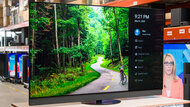


We buy and test dozens of TVs yearly, taking an objective, data-driven approach to deliver results you can trust. Our testing process is complex, with hundreds of individual tests that take over a week to complete. Most of our tests are done with specially designed test patterns that mimic real content, but we also use the same sources you have at home to ensure our results match the real-world experience. We use two main tools for our testing: a Colorimetry Research CR-100 colorimeter and a CR-250 spectroradiometer.
-
Best Samsung TV
 Mixed Usage8.9Home Theater9.0Bright Room8.8Sports8.8Gaming9.3Brightness8.7Black Level10Color9.1Processing (In Development)8.3Game Mode Responsiveness9.4Resolution4kNative Refresh Rate165HzScreen FinishMattePanel TypeOLEDSub-TypeQD-OLEDSee all our test resultsDolby VisionNo
Mixed Usage8.9Home Theater9.0Bright Room8.8Sports8.8Gaming9.3Brightness8.7Black Level10Color9.1Processing (In Development)8.3Game Mode Responsiveness9.4Resolution4kNative Refresh Rate165HzScreen FinishMattePanel TypeOLEDSub-TypeQD-OLEDSee all our test resultsDolby VisionNoThe best Samsung TV we've tested is the Samsung S95F OLED. It's an outstanding QD-OLED that delivers impressive overall picture quality. Like TVs that use a traditional WOLED panel, the TV delivers the same inky blacks in a dark room with no blooming, but colors have increased vibrancy. Combine that with the TV's outstanding brightness, and highlights really pop out in HDR content. Due to the TV's incredibly wide viewing angle, the image remains clear when viewed from the sides, making it well-suited for watching content with friends. It's also the only OLED model on the market with a matte screen coating, and when you combine that with the TV's brightness, you get a model that essentially eliminates reflections in even the brightest rooms.
Unlike high-end TVs from other brands, the S95F doesn't support the Dolby Vision format that many streaming services and 4k Blu-rays use. Instead, it supports the similar HDR10+, which is similar but a bit less common. It also doesn't support DTS audio formats, so you need a receiver if you want to listen to movies in that format. It runs the Tizen OS, so finding apps is easy. When it comes to gaming, the TV is absolutely loaded with features. It has HDMI 2.1 bandwidth on all four ports, 4k @ 165Hz, VRR, and low input lag. Additionally, fast motion is crystal clear due to its nearly instantaneous response time, so gaming on this TV is remarkable.
For more options from Samsung, check out the best Samsung TVs.
-
Best Sony TV
 Mixed Usage8.6Home Theater8.8Bright Room7.3Sports7.8Gaming8.7Brightness7.9Black Level10Color8.7Processing (In Development)8.9Game Mode Responsiveness8.8Resolution4kNative Refresh Rate120HzScreen FinishGlossyPanel TypeOLEDSub-TypeQD-OLEDSee all our test resultsDolby VisionYes
Mixed Usage8.6Home Theater8.8Bright Room7.3Sports7.8Gaming8.7Brightness7.9Black Level10Color8.7Processing (In Development)8.9Game Mode Responsiveness8.8Resolution4kNative Refresh Rate120HzScreen FinishGlossyPanel TypeOLEDSub-TypeQD-OLEDSee all our test resultsDolby VisionYesThe best Sony TV currently on the market is the Sony BRAVIA 8 II OLED. It has a lot in common with the Samsung S95F OLED, since they both use QD-OLED panels that deliver inky blacks, punchy colors, and bright highlights in HDR, so the TV provides excellent image quality. The TV supports Dolby Vision and DTS audio passthrough, so it has great compatibility with physical media and streaming services. Speaking of streaming, this model comes equipped with the popular Google TV OS that gives you access to a huge catalogue of apps, so you won't struggle to find content to watch. On top of that, you get Sony's top-tier image processing, which makes low-quality and low-resolution content look pretty good.
The TV has solid reflection handling, so reflections aren't an issue in moderately lit rooms. However, it's a bit too dim to completely overcome glare in very bright environments, and blacks are raised and have a bit of a purple tint. Fortunately, it has a very wide viewing angle, so you get a consistent image no matter where you're seated. It's also a great option for console gaming due to its HDMI 2.1 bandwidth, 4k @ 120Hz, VRR, low input lag, and incredibly clear motion. Unfortunately, the TV is only available in 55-inch and 65-inch sizes. However, you can still find the very similar Sony A95L OLED in a 77-inch size, so go with that model if you need something larger and still want a Sony QD-OLED.
You can also check out the best Sony TVs for more options.
-
Best LG TV
 Mixed Usage9.0Home Theater9.0Bright Room8.7Sports8.8Gaming9.1Brightness8.9Black Level10Color8.9Processing (In Development)8.8Game Mode Responsiveness9.2Resolution4kNative Refresh Rate165HzScreen FinishGlossyPanel TypeOLEDSub-TypeWOLEDSee all our test resultsDolby VisionYes
Mixed Usage9.0Home Theater9.0Bright Room8.7Sports8.8Gaming9.1Brightness8.9Black Level10Color8.9Processing (In Development)8.8Game Mode Responsiveness9.2Resolution4kNative Refresh Rate165HzScreen FinishGlossyPanel TypeOLEDSub-TypeWOLEDSee all our test resultsDolby VisionYesThe best LG TV we've tested is the LG G5 OLED. It uses LG's new primary RGB tandem panel on all sizes except the gigantic 97-inch model and is designed for increased color vibrancy and brightness. This extra brightness delivers highlights that really pop when watching HDR content, and the TV easily overcomes glare in a bright room when watching SDR content. The TV truly shines in dark rooms due to its perfect black levels, so you get inky blacks with no blooming around subtitles or bright highlights. It delivers vibrant, lifelike, and bright colors that are close to what you get from QD-OLEDs, so HDR content packs a punch. It's also a fantastic TV for watching content with friends due to its incredibly wide viewing angle.
The TV also supports Dolby Vision, which is great for those who want to take advantage of streaming services or 4k Blu-rays that use it as their main HDR format, but it doesn't passthrough DTS audio formats commonly found on Blu-rays. It comes with LG's webOS, which is loaded with smart features and apps. This is also one of the best TVs you can currently buy for gaming. It has HDMI 2.1 bandwidth on all four ports, 4k @ 165Hz, supports VRR, and has crystal clear motions, so it pairs perfectly with modern gaming consoles or gaming PCs.
Take a look at the best LG TVs for more options.
-
Best Panasonic TV
 Mixed Usage8.9Home Theater8.9Bright Room8.2Sports8.4Gaming9.2Brightness8.5Black Level10Color8.8Processing (In Development)8.7Game Mode Responsiveness9.4Resolution4kNative Refresh Rate144HzScreen FinishGlossyPanel TypeOLEDSub-TypeWOLEDSee all our test resultsDolby VisionYes
Mixed Usage8.9Home Theater8.9Bright Room8.2Sports8.4Gaming9.2Brightness8.5Black Level10Color8.8Processing (In Development)8.7Game Mode Responsiveness9.4Resolution4kNative Refresh Rate144HzScreen FinishGlossyPanel TypeOLEDSub-TypeWOLEDSee all our test resultsDolby VisionYesThe best Panasonic TV we've tested is the Panasonic Z95B OLED. It uses the new primary RGB tandem panel found in the LG G5 OLED, so it offers impressive brightness and punchy colors. This means that highlights and colors really pop out in HDR content. Combine that with the TV's perfect black levels, and you get a top-tier HDR viewing experience in a dark room. On top of that, the TV has the SDR brightness and reflection handling needed to overcome glare in a well-lit room. Furthermore, it has excellent image processing, which is great to have when your content is suboptimal, so it's a versatile model. It also has a very wide viewing angle, so it's suitable for wide seating arrangements. To top it off, it's very accurate out of the box, so this model respects the filmmaker's intent without calibration.
This is one of the rare OLED models that supports both HDR10+ and Dolby Vision, so this TV has amazing HDR compatibility, regardless of the source. However, it doesn't passthrough DTS audio formats, so you need to connect your devices directly to a receiver or soundbar if you want to listen to movies in that format. The TV utilizes the Fire TV OS, which gives you access to popular streaming apps. It's also a fully featured gaming TV with HDMI 2.1 bandwidth, 4k @ 144Hz, VRR, and nearly instantaneous pixel transitions for crystal-clear motion.
-
Best TCL TV
 Mixed Usage8.4Home Theater8.6Bright Room8.4Sports8.3Gaming8.4Brightness9.1Black Level9.2Color8.0Processing (In Development)7.8Game Mode Responsiveness8.0Resolution4kNative Refresh Rate144HzScreen FinishGlossyPanel TypeLCDSub-TypeVASee all our test resultsDolby VisionYes
Mixed Usage8.4Home Theater8.6Bright Room8.4Sports8.3Gaming8.4Brightness9.1Black Level9.2Color8.0Processing (In Development)7.8Game Mode Responsiveness8.0Resolution4kNative Refresh Rate144HzScreen FinishGlossyPanel TypeLCDSub-TypeVASee all our test resultsDolby VisionYesThe best TCL TV we've tested is the TCL QM8K. It's an excellent all-around Mini LED model that performs well in almost any usage case. It has outstanding brightness and does a very good job handling indirect reflections, but it's best to avoid any direct light sources facing the screen, as those are visible during most scenes. Colors are incredibly vibrant due to its quantum dot technology, blacks are very deep thanks to its fantastic local dimming, and highlights truly pop out in HDR content, so this TV is a great option for a home theater. It supports Dolby Vision, HDR10+, and DTS audio passthrough, so you're totally covered no matter what you're watching. Unfortunately, its viewing angle is a bit narrow, so although it's fine if you're watching from a slight angle, it's not the best option for wide seating arrangements.
Not only is this model great for watching content, but it's also a great choice for gamers. It supports 4k @ 144Hz, 1080p @ 288Hz, and VRR, so it pairs well with modern consoles and PC rigs. It doesn't have the same nearly instantaneous pixel transitions you get from OLEDs, but it's pretty quick for an LED model, so motion blur is kept to a minimum. It runs Google TV OS, so you get smart features like voice control and a massive catalogue of apps to download. You could also opt for the more expensive TCL QM9K, which is even brighter than the QM8K. However, the QM8K actually performs better overall, and it's more affordable, so it's the better option for almost anyone.
You can check out the best TCL TVs for more options.
-
Best Hisense TV
 Mixed Usage8.4Home Theater8.5Bright Room8.7Sports8.3Gaming8.3Brightness9.2Black Level8.7Color8.4Processing (In Development)7.5Game Mode Responsiveness7.6Resolution4kNative Refresh Rate165HzScreen FinishGlossyPanel TypeLCDSub-TypeVASee all our test resultsDolby VisionYes
Mixed Usage8.4Home Theater8.5Bright Room8.7Sports8.3Gaming8.3Brightness9.2Black Level8.7Color8.4Processing (In Development)7.5Game Mode Responsiveness7.6Resolution4kNative Refresh Rate165HzScreen FinishGlossyPanel TypeLCDSub-TypeVASee all our test resultsDolby VisionYesThe Hisense U8QG is the best Hisense TV we've tested that's available to purchase. It provides an excellent overall picture quality and is a versatile TV that looks great in both bright and dark rooms. It displays incredibly deep blacks in a dark room, with minimal blooming, which is great for watching movies or shows. Although it's best to avoid placing direct light sources facing the screen for the best visibility, this model is a very bright option with solid handling of indirect reflections, so it has no problem overcoming glare from overhead lights. Regardless of your lighting conditions, the TV displays vibrant and lifelike colors that are sure to please. It also supports all major HDR and audio formats, so you're covered no matter how you watch content. Unfortunately, the TV really overbrightens HDR content, which will bother those who want the most accurate TV possible.
This TV is also packed with modern gaming features. It has HDMI 2.1 bandwidth on two ports, 4k @ 165Hz, 1080p @ 288Hz, and VRR support, so it can take full advantage of modern gaming consoles and can be paired with PCs that have high-end graphics cards. Its response time is fast, especially for an LED TV, so motion blur is kept to a minimum. Finally, its viewing angle is wide enough for watching from a slight angle, but image quality is noticeably degraded from more aggressive angles.
See the best Hisense TVs to check out some other models.
-
Best Roku TV
 Mixed Usage7.7HDR Movies7.8Sports7.3Video Games8.7Resolution4kNative Refresh Rate120 HzScreen FinishSemi-glossTypeLEDSub-TypeVASee all our test resultsDolby VisionYes
Mixed Usage7.7HDR Movies7.8Sports7.3Video Games8.7Resolution4kNative Refresh Rate120 HzScreen FinishSemi-glossTypeLEDSub-TypeVASee all our test resultsDolby VisionYesThe best Roku TV we've tested is the Roku Pro Series 2024. Overall, it's a good TV with an effective local dimming feature that helps improve black levels during dark scenes, although some blooming is noticeable around brighter highlights. It's also a bright TV that effectively fights glare in most well-lit rooms, but any light sources facing the screen are quite visible. Fortunately, you get vibrant and lifelike colors that stand out; however, it's not the most accurate TV, so some colors don't appear as intended. It supports Dolby Vision and HDR10+, ensuring you're covered regardless of how you watch your content. It doesn't support DTS audio formats, so it's not the best option for those with a physical media collection who don't have a receiver. Sadly, this TV has a narrow viewing angle, so it's best to stay seated directly in front of the screen when possible.
Fortunately, the TV is quite good for gamers, as it has HDMI 2.1 bandwidth, 4k @ 120Hz, and supports VRR. However, there's noticeable motion blur in faster games. You get the built-in Roku interface, which is fast and easy to use, like their streaming devices are. Although Roku is newer to TV manufacturing, their Pro Series proves they're a company to look out for when you're looking for the best smart TV brand.
If you need something cheaper, take a look at the best Roku TVs.
-
Best Vizio TV
 Mixed Usage7.5HDR Movies6.9Sports7.8Video Games8.2Resolution4kNative Refresh Rate120 HzScreen FinishSemi-glossTypeLEDSub-TypeIPSSee all our test resultsDolby VisionYes
Mixed Usage7.5HDR Movies6.9Sports7.8Video Games8.2Resolution4kNative Refresh Rate120 HzScreen FinishSemi-glossTypeLEDSub-TypeIPSSee all our test resultsDolby VisionYesVizio doesn't release many TVs in the United States anymore, but the Vizio Quantum Pro QLED is the best Vizio TV we've tested that's still available to purchase. While OLEDs are fantastic for dark rooms, an LED TV like this is ideal for a room with many bright lights, as it features the SDR peak brightness needed to combat glare. It's bright enough in HDR for highlights to stand out a bit in HDR content, but despite the TV having local dimming, it doesn't display deep enough blacks to truly impress. There's also blooming around highlights, which also affects the TV's overall black levels.
It displays a wide range of colors, and it supports Dolby Vision, HDR10+, and DTS audio formats, which is great if you're looking for a TV to watch movies and shows. Sadly, it has poor image processing, so stick to high-quality and high-resolution sources. Luckily, it's a very good gaming TV with HDMI 2.1 bandwidth, 4k @ 120Hz, 1080p @ 240Hz, low input lag, and VRR.
See the best Vizio TVs for additional alternatives.
Recent Updates
Jan 09, 2026:
We replaced the Sony A95L OLED with the Sony BRAVIA 8 II OLED in the 'Best Sony TV' category since the former is no longer available in most sizes.
Nov 26, 2025:
We confirmed the accuracy and availability of our current picks.
Oct 28, 2025:
Replaced the Panasonic Z95A with the Panasonic Z95B in the 'Best Panasonic TV' category. We also added a mention of the TCL QM9K in the 'Best TCL TV' category.
Aug 20, 2025:
We replaced the Samsung S95D OLED with the Samsung S95F OLED, the LG G4 OLED with the LG G5 OLED, the TCL QM851G with the TCL QM8K, and the Hisense U8N with the Hisense U8QG. We also refreshed a lot of text throughout the article for clarity.
Apr 15, 2025:
Replaced the Vizio P Series Quantum 2021 with the Vizio Quantum Pro QLED due to availability. We also tweaked some text throughout the article for accuracy.
All Reviews
Our recommendations above are what we think are currently the best TVs available from the eight biggest TV brands in the U.S. There's not a definitive best smart TV brand, and all models on this list are loaded with features, so it really comes down to what OS you prefer if smart features are important to you.
If you would like to do the work of choosing yourself, here is the list of all our TV reviews. Be careful not to get too caught up in the details. While no TV is perfect, most TVs are great enough to please almost everyone, and the differences are often not noticeable unless you really look for them. Also, keep in mind that our scores aren't comparable across different test benches, so the older TVs in the list below score higher than they would today.
